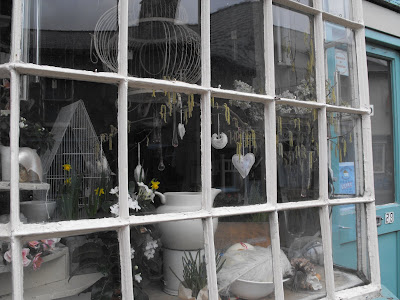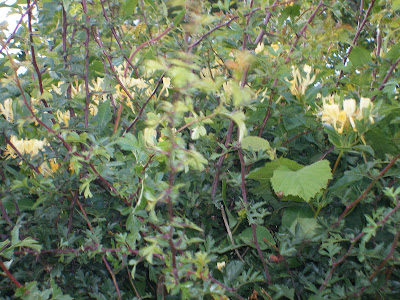
I've just realized that I haven't written this up yet - though some of the photos are over on Nature Notes. On Thursday I did a walk from Court Henry (where my husband dropped me off), and up along a trackway which formed two sides of a square leading back to a road on the top end. Then I left the village behind me and walked back up towards Llanfynydd. The sun was out, occasionally, and it really felt like spring was tentatively coming out of hiding.
All sorts of wild flowers are putting out leaves in the shelter of the hedgerow - Dogs Mercury, Lords and Ladies, overwintered Foxgloves, Stitchwort, Ground Ivy, masses of Cow Parsley leaves which were even pushing through the winter snow this year, much as they have in milder winters recently. In sheltered spots, leaves of various wild geraniums, especially the Shining Cranesbill which always flowers early. There were flowers on the barren strawberries too and of course, the gorse coverts were well in bloom. Just the time to pick flowers for Gorse Wine.
I took a short cut back through the grounds of Pantglas, once a beautiful Italianate mansion, but then its fate was sealed once it came into Council hands and housed the mentally ill of the county. It is now demolished, all bar the tower, and the grounds house a series of holiday log cabins . . . It's history is here: http://www.llanegwad-carmarthen.co.uk/pantglashall.htm
I watched the ducks on the lake in front of the former stable yard, and had a lovely chat with the groundsman, who told me all sorts of stories about the wildlife of the area, and where various birds of prey nested and lots of duck-talk! I walked around the bigger lake in front of the house - or rather, the tower, which is all that remains of it now. The maintenance of old buildings is not usually a priority with local Councils . . . and of course it was demolished.
Fortunately the lane home was downhill after that, though our hill took some climbing as my legs were quite tired by then. I must get back into the routine of the daily walk which fell by the wayside during the perishing cold days of January and early February. As for sayings, "February fill-dyke" - not this year. We had our "peck of March dust" ("worth king's ransom") THIS month instead - unheard of in Wales. I do hope this doesn't mean a dry winter equals a wet summer.
 January lambs are quite well-grown now.
January lambs are quite well-grown now. Just to the right of this first upright fence wire in is a curious valley. i cannot decide whether it is totally natural (flat bottomed too) or navvied out for some reason - it doesn't look like the normal quarries we have around here, which tend to be into the side of a hill. The railway never ran this way . . .
Just to the right of this first upright fence wire in is a curious valley. i cannot decide whether it is totally natural (flat bottomed too) or navvied out for some reason - it doesn't look like the normal quarries we have around here, which tend to be into the side of a hill. The railway never ran this way . . . Looking across different fields to Black Mountain beyond.
Looking across different fields to Black Mountain beyond. The tower of Pantglas hoves into view.
The tower of Pantglas hoves into view. A close-up - all that remains of the grand Italianate mansion house build in the 1830s.
A close-up - all that remains of the grand Italianate mansion house build in the 1830s. The wonderful stable block was retained, but turned into a gym, cafe, games room, and restaurant etc.
The wonderful stable block was retained, but turned into a gym, cafe, games room, and restaurant etc. The lake in front of the house and below, a wonderful patch of snowdrops.
The lake in front of the house and below, a wonderful patch of snowdrops.






































